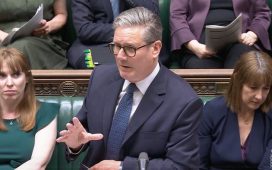Unlock the Editor’s Digest for free
Roula Khalaf, Editor of the FT, selects her favourite stories in this weekly newsletter.
The partnership between state-owned GB Energy and the Crown Estate, unveiled by energy secretary Ed Miliband on Thursday, is being touted as a way to accelerate the building of thousands of offshore wind turbines in the UK over the coming years.
Miliband has argued that a surge in domestic renewable capacity can increase Britain’s energy security and provide cheap, clean power. Yet the Labour government still faces questions about whether it can hit its ambitious target of a decarbonised power system by 2030 — not least due to long-standing delays for new wind and solar farms to connect to the electricity grid — and whether GB Energy is the answer.
Ministers are rushing through legislation to set up Scotland-based GB Energy, which will have £8bn of taxpayer money to spend on stakes in renewables projects or even operate its own schemes.
Crucial to Thursday’s announcement is the idea that closer co-operation means GB Energy can bring more strategic heft to the Crown Estate, while giving its projects greater access to public capital.
The government claimed the partnership would lead to up to 20GW-30GW of new offshore wind developments securing seabed leases by 2030.
But this is not a new development — the Crown Estate had already set that target in November, long before the deal with GB Energy.
The deal also prompted headlines about it generating enough wind power for 20mn homes by the end of the decade. Yet many of the projects will not be generating electricity until 2040, given projects can take up to a decade after winning their seabed lease to start operating.
Government officials insist the partnership does make it more likely that the 2030 net zero power target would be hit, however. “The old government had targets without delivery,” said one.
The government claimed that the GB Energy tie-up with the Crown Estate, which manages the monarch’s legacy portfolio of land and seabed, could help attract £30bn-£60bn of private sector investment for offshore wind turbines and other, earlier-stage technology, such as carbon capture and hydrogen.
However, proposals for GB Energy to carry out development work for offshore wind projects, such as scoping out the seabed and navigating the planning process, triggered some concern among industry about the state potentially taking too big a role in a market which has been broadly successful so far.
The UK has the largest offshore wind capacity outside of China, with the private sector investing heavily over the past decade with the support of government guarantees on the price they can earn for the electricity they produce.
“Companies view it as a strategic advantage to do [development work] quicker and faster than others,” said one industry source. “The risk is that it’s even slower as no one in the state is used to doing this yet.” There is also the risk GB Energy could deter private investment, trigger unfair competition concerns, or simply replicate work already being done by the Crown Estate.
“The next steps of its development will have to be formed in close partnership with the sector,” said Dan McGrail, chief executive of trade group RenewableUK. “In the offshore wind industry alone, over £100bn of private capital will be needed to deliver the government’s target of 60GW by 2030.”
However, much remains outside the control of the Crown Estate, which announced that profits more than doubled on Wednesday — mostly thanks to wind seabed leases.
For example, the Ministry of Defence has intervened on various occasions to try to block new wind farms because of concerns over their impact on aerodromes, explosive stores, radar facilities and range areas. This year, it resisted a proposal for an extension to the Clashindarroch wind farm near a tactical training area for pilots at RAF Lossiemouth.
People in Whitehall told the Financial Times that the Crown Estate’s next leasing round, for floating offshore wind in the Celtic Sea, was scaled back from a potential 6.5GW of capacity to 4.5GW after an intervention from the MoD.
Constraints on the capacity of the electricity grid to take power from offshore wind farms on to land and around the country remain a huge problem. “The biggest challenge is going to be connections to the grid,” said Alasdair Grainger, net zero managing director at Grant Thornton.
One Tory MP said that Miliband had focused on the supposed shortage of capital for the sector when the problems for the renewable sector were instead a lack of community consent, environmental hurdles and a dearth of grid connections.
“The decision to have the public sector take on additional early development work is a positive move that will reduce risk for developers and attract greater private investment,” said James Alexander, chief executive of the UK Sustainable Investment and Finance Association.
“One barrier this will not solve is the current inadequacy of our grid connections, which we know remains a major barrier to investment.”
Climate Capital

Where climate change meets business, markets and politics. Explore the FT’s coverage here.
Are you curious about the FT’s environmental sustainability commitments? Find out more about our science-based targets here










